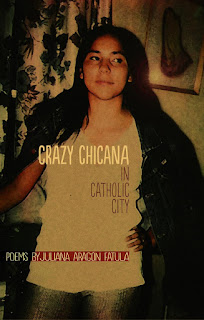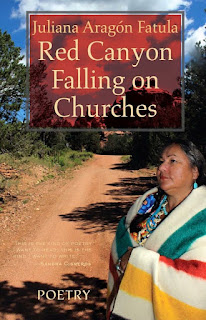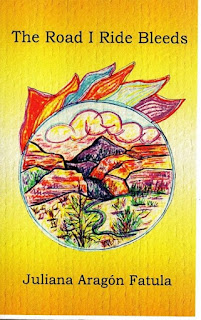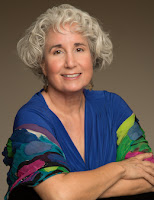My Notes on Writing by Juliana Aragon Fatula
Dear Reader,
taken since I began this journey to teach myself how to write a mystery. My notes are from the following books on writing mysteries: Linda Rodriguez’ Plotting the Character Driven Novel recommends these books on writing: Carolyn See’s Making a Literary Life, Dorothea Brande’s Becoming a Writer, Natalie Goldberg’s Writing Down the Bones, Julia Cameron’s The Artists Way, Stephen King’s On Writing: A memoir of the Craft, Madeleine L”Engle’s A circle of Quiet, Leonard Bishop’s Dare to Be a Great Writer, Elizabeth George’s Write Away, One Writer’s Approach to Fiction and the Writing Life, Brenda Ueland’s, If You Want to Write a Book About Art, independence, and Spirit, John Gardener’s On Becoming A Novelist, Annie Dillard’s The Writing Life, Ursula K. LeGuin’s Steering the Craft: Exercise and Discussion on Story Writing for the Lone Navigator or the Mutinous Crew.
Life happens.
bed. His suitcase sat by the door to move into assisted living the next day. He
was the last of my Father’s generation of ten siblings.
home with my husband and son. I read Mary Oliver’s poem “Sometimes”
from Red Bird. I sang an Ojibway death song and shared my family story of
mi tió Joe. I didn’t know him well, but I knew his caregiver, my
cousin, tió Joe’s niece. She asked me to do a reading, claro que sí.
brother in low, Frank’s funeral. I’ve known him since I was eight years
old. I shared my favorite memory of Frank for his children, grand-children
and great grandchildren.
The death of her father was particularly difficult
for my favorite niece because she had been his caregiver for years before
Hospice lent a hand.
It was regional. My hometown is predominately white. My family are Mexican
Indians, Chicanos. Frank’s kids are half Irish Chicanos. His great
granddaughter is part Irish, Indian, and Puerto Rican. She’s blue-eyed but dark
skinned. My husband is white. My son from a previous relationship is puro
Chicano.
the grandkids of the woman who had been my mother’s best-friend, Mary.
She was a Chicana. Her sons played in my parent’s
yard with my brother when we were kids. I realized my generation is now the
ancestors. Our ancestors have all passed and gone to the party in the sky to
join their loved ones.
Two funerals this week were in my hometown. The
first funeral was in Pueblo, a predominately Chicano community. The
funeral in Pueblo this week was a Chicano funeral orchestrated by Rev. Lucero.
He wore a tailored black suit, white crocodile cowboy boots, rings and chains
and turquoise. He gave me ideas for a character in my mystery. He did the
service in Spanish and English. He played his guitar and sang old Mexican
corridos. It was memorable.
daughter, and grandkids id not attend. There was no reception or gathering
afterward. He received full military honors for his service. The flag was
presented to his niece, his caregiver.
All of tió Joe’s brothers and sisters and parents wait for
him in the next world to complete the circle of life. I read a poem about a bird. I sang a death song about a
bird walking in the sky. Here were tears ands miles and hugs.
from Hospice and a recording of Elvis Presley singing Amazing Grace. Frank’s children invited
my husband, son, and I to the wake. There was bountiful food, beer, alcohol.
She’s my favorite because she spent the night at the hospital with me the night
my Mother died. It’s a memory we share that no one in the family has. It’s our
memory of Mother’s passing while we held her hand and tried to keep each other
awake. My husband works at the hospital, so he kept us coffee’d-up. He was
there in the room when she passed. My Mother called my husband the Energizer
Bunny.
niece and nephews. They call me tía. Frank’s funeral hit me hard.
traditional. I didn’t have the energy after three funerals to visit Mary’s
wake. I said good bye to her and asked her to tell my Mother and Father hi for
me. Seeing her open casket was mistake for me, it reminded me of my Mother’s
funeral ten years ago. I see my Mother welcoming, Mary, Frank, Joe her best
friend, son in law and brother in law to heaven. I feel her presence near me. I
feel my Father’s spirit everywhere especially in Villa Nueva, New Mexico when
we visit the place he was born in 1917.
person. And to write a will and prepare for my day to join them.
notes for character’s in my mystery. The sights, sounds, smells of incense in
the cathedral, the perfume of the women I hugged, the difference between the
Chicano funeral in Pueblo, the Chicano funeral in my hometown, and the Irish
funeral at the funeral home my family has used my entire life. This week will
be memorable, but he older I get, the more funerals I attend. The circle of
life.
master writer’s I’ve studied on the art of writing a mystery. Answering these
questions and exploring some of the writing assignments helped me to get
started. I hope they help you, too.
touch that would startle or frighten her/him?
them distinctive mannerisms or a relatable conflict that is odd or unusual.
nervous?
mystery.
and/or learns about her/himself?
take in the story?
soft spots and flaws.
especially women in non-traditional careers.
demonstrates an ability or skill to overcome the bad guy.
guy.
rescue a friend.
protagonist developed and mastered this skill.
A final note, because my life is diverse, so are
my characters. I chose Chicanas for my private investigation team. I wrote
characters that are transgender, bisexual, gay, and celibate. My characters are
Chicano, white, black, Jamaican and Chinese. They have unusual mannerisms and
speak with different colloquialisms. They are based on people I know and people
I have yet to meet. But they are real people will real histories and real
problems. Think about making your characters diverse like the world we live in
and create your world in your mind full of colorful personalities. I hope this
helps you. The books I’ve studied helped me immensely and I’ve learned from the
masters of mystery how to tell a great story.





